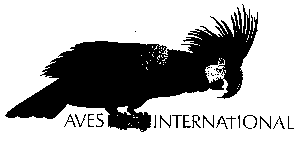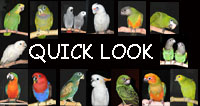 |
|
|
|
|
|
|
|
|
|
|
|
|
|
|
|
|
|
|
|
Main Page
|
(prices and availability) |
 |
 |
|
|
|
|
|
|
|
|
|
|
|
|
|
|
|
|
|
|
|
|
(prices and availability) |
 |

Q. Why does my bird scream?
A. Birds make noise in their native habitats to communicate with one another. It has been documented through field research that some species have regional variations of their calls. In a study of Yellow-Naped Amazons (Amazona auropalliata) in Costa Rica, birds from the southern end of the natural range did not understand and react to calls from the same species from the northern end of the range. Thus birds have complex vocabularies to communicate with one another to announce the dawn or sunset, to indicate the approach of a predator, to notify the sighting of food trees, to acknowledge a change in weather, etc., etc. Just as we humans use language to interact with one another, birds use their own unique avian language in their daily lives. Smaller birds that live in flocks, such as conures, communicate with the flock constantly throughout the day. In a captive environment, in the absence of a flock of peers, a single conure will call to its human contacts for reassurance and communication. This is absolutely normal, instinctive behavior and it is unreasonable to think the bird should stop calling to us because we feel it is bothersome. Cockatoos can be quite vocal in captivity to the dismay of their owners. In their natural habitats, cockatoos are quite noisy and the males often clear branches from the highest points of tall trees where they sit, display, and emit ear-splitting calls to defend territory and nesting sites. To expect cockatoos to be quiet in captivity is unreasonable. Before choosing a bird for a pet, one should become familiar with the characteristics of the species under consideration so that there are no unreasonable expectations of the bird that cannot be met.
Q. Why does my parrot/cockatoo/macaw/other psittacine species chew the furniture/woodwork in the house?
A. Parrot-type birds live in and around trees in their native habitats. Therefore they have access to wood and plant material, most of it alive and growing, on a consistent basis. Most bird species eat and chew fresh plant material in their native habitats and have ample opportunity to clean and sharpen their beaks and nails on wooden material. In captivity, birds are often kept in metal/wire cages with hard wooden perches, such as manzanita wood, that are difficult to chew. Parrots crave this beneficial activity and need to chew to maintain proper beak and nail lenghts. Psittacines deprived of wood-chewing (especially those on an inadequate diet) can develop overgrown beaks and nails. A fine stereo cabinet would be irrestible to a wood-deprived cockatoo or macaw! Give your psittacines soft wood for chewing such as chunks of pine two by four planks. Fresh green branches are relished by most parrot species. The birds will strip the leaves and bark, ingesting beneficial cellulose. Some species will bathe in dampened green, leafy branches. Parrots also really enjoy chewing the cardboard tubes from paper towel rolls. This is an inexpensive and readily procured toy for your bird. Providing these chewing opportunities for you psittacine bird will keep it healthier and happier and make it less likely to chew forbidden wood at the earliest opportunity. In any case, never blame a parrot that has chewed furniture or woodwork as it is merely following its natural instinctual impulses. P.S. Please, if you breed birds- give them natural wood nesboxes, not metal nestboxes. Metal is cold in the winter, hot in the summer and offers no opportunity for parrots to chew the nest site as they would do in the wild.
Q. Why does my bird like me but not other members of my family/my husband /my wife/ my son/my daughter/my friend/etc. ?
A. As many birds pair bond for life in the wild, many bird species (especially parrot-type species) will "pair bond" to one person or sometimes just male or female humans (usually opposite the sex of the parrot). There are many variations on this theme and indeed, there are gregarious individuals that are tame and affectionate with many people, even strangers. The socialization of the individual bird is a crucial factor in determining how it will react to people. A bird that experiences gentle attention from a number of people at an early age is more likely to accept new people and/or several people later in life.
Q. Why does my bird waste food?
A. As part of a natural ecosystem, the eating patterns of birds are integral parts of the whole system. Thus when birds peel and eat flowers, fruits, nuts, and berries in their natural habitats, they are pollinating, distributing seed, fertilizing, and in other subtle ways, influencing their environment in a positive way. It is natural for a bird to drop pieces of whatever food it is eating. In the tropical and subtropical environments in which most parrot-type birds are native, there often will be an abundance of a particular type of fruit or nut ripening at the same time. Birds will eat such fruits en masse, dropping some in the process. This affords an opportunity for ground-dwelling animal species to have access to food and also to the plant's pollen or seeds, providing more opportunity for their distribution. When you see foodstuffs spattered on your flooring, try to visualize your home as an ecosystem, with your parrot doing its best to be a contributing member of the whole system (just kidding ;^) ).
|
|
Main Page |